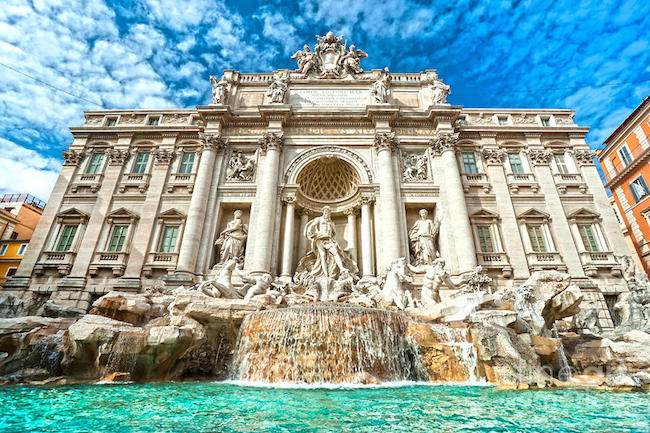Why stop at the Palace of Fine Arts when there’s a whole world of cultural landmarks to exploit?

By Laura Fraser
NOVEMBER 18, 2015 — Editor’s Note: This Thursday (Thu/19), the San Francisco Parks and Recreation Commission will meet to review three proposals to turn the Palace of Fine Arts, which was built as part of the 1915 Pan Pacific International Exposition, into a pricey restaurant and hotel complex. In one week, a petition on change.org has gathered 20,000 signatures against the plans — and a protest is planned for tomorrow.
Since its construction for the Pan-Pacific Expo of 1915, the Palace of Fine Arts has been our little Versailles, our Brandenburg Gate, our Trevi Fountain. Below, writer Laura Fraser considers what similar proposals — based on actual proposals for the Palace of Fine Arts — would look like if, in fact, they were directed toward the future of Rome’s famous and beloved Trevi Fountain:
THE NICOLA SALVI CENTER AT THE TREVI FOUNTAIN
The Nicola Salvi Center at the Trevi Fountain will offer a unique combination of cultural, historic, entertainment and hospitality facilities. Our team has unparalleled experience rehabilitating historic buildings (the shopping rotunda in the Pantheon, the 200-room hotel at the Spanish steps, the mall at the Colosseum). The Salvi Center at the Trevi Fountain will include: Complete rehabilitation of the 1762 fountain, with a sky-lit visitor entrance and central dining court. The central court will integrate cultural and historic exhibits, including continuous screenings of Federico Fellini’s film La Dolce Vita. On-site gelateria.
EQUITY COMMUNITY BUILDERS TREVI FOUNTAIN
Our vision for the Trevi Fountain is to create a grand public concourse that embraces the history, arts, products, crafts and culture of Rome, particularly celebrating the fountain’s legacy, with interactive exhibits showing how, in 19 BC, thirsty Roman soldiers were guided by a young girl to a source of pure water, which led Augustus to commission the construction of an aqueduct into the city. We envision a lively, interactive public experience, including a cooking school, trattoria, pizzeria, cafes and a small marketplace; outlets for Roman crafts and products (Prada, Fendi, Armani), and places where families and kids of all ages can play and learn — splashing in the fountain, and dropping in coins. The coins will be a powerful revenue generator. The iconic Trevi Fountain will be sensitively rehabilitated to preserve and honor the past, with approximately 175 guest rooms at two new mezzanine levels. Water from the Trevi Fountain will be marketed to visitors, in bottles embossed with the Trevi Fountain papal coat of arms.
SFMAP CONSORTIUM TREVI FOUNTAIN
(SFMAP) Consortium’s proposal for the Trevi Fountain is to give Nicola Salvi’s original design a revived civic presence by creating a mixed-use destination comprised of a new great Hall at the Fountain, as well as a destination fine dining restaurant. The restored fountain will serve as a critical architectural element marking Rome’s commitment to public gathering places where history, innovation and conversations are celebrated. A large central hall will be inserted into the heart of the fountain. Rome Museum at The Trevi Fountain is a storytelling museum sharing the untold story of Rome (the rise and fall of the Roman Empire, the Renaissance, the Kingdom of Italy, etc.) with the City, the region, and the rest of the world. It is exactly the type of public program and long lasting public use consistent with Nicola Salvi’s original Baroque masterpiece.



